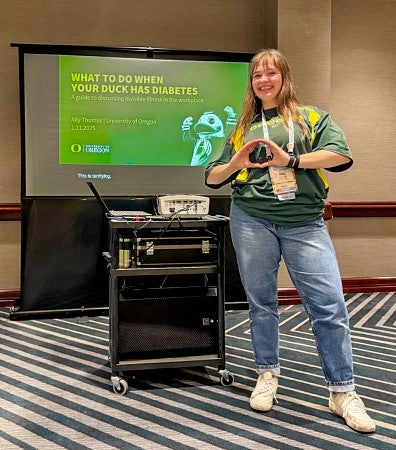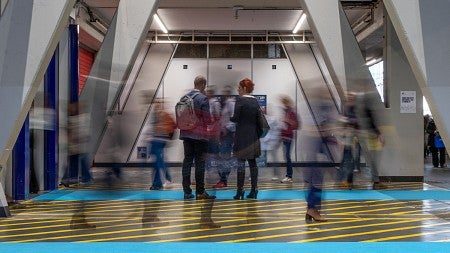Ally Thomas ’25 turned her passion for diabetes advocacy into a global photojournalism project.

by Ethan Donahue, Class of ’26
For Ally Thomas ’25, a recent advertising graduate of the UO School of Journalism and Communication (SOJC), storytelling isn’t just a career goal — it’s a personal mission. This spring, Thomas took that mission across the globe to Amsterdam, where she attended the 18th annual Advanced Technologies & Treatments for Diabetes (ATTD) international conference, thanks to funding from the SOJC’s experiential learning support fund.
Entering with a camera, a press badge and the curiosity of a lifelong learner, Thomas immersed herself in five days of global networking, cutting-edge research and community connection. Her goal was to document the many stories of diabetes to raise awareness and build compassion.
The conference brought together over 5,000 researchers, clinicians and advocates from more than 90 countries, all dedicated to improving the lives of people with diabetes. For Thomas, who lives with type 1 diabetes, the experience was personal, eye-opening and deeply affirming.
“I didn’t really know what to expect going in,” she said. “ I think going in with no expectations was really nice because whatever was coming my way, I was able to stay in the mindset of , ‘OK, let’s just roll with it.’”
Being among others who live with and work alongside people with diabetes was comforting. “It was really neat because you knew that everyone who was there understood what you were going through on a day-to-day basis without it really being spoken,” she said.
Chasing the ‘unifying heartbeat’ of storytelling

Thomas’s academic path wasn’t always so clear. She arrived at the University of Oregon as an exploring student, undecided about her major but certain about two things: her love of connecting with people and her deep desire to make a difference in the diabetes community, specifically regarding the representation of type 1 diabetes.
She knew she wanted to work within the diabetes community, but her first idea on how to approach the topic — medicine — wasn’t quite the right fit.
“There’s something about working hands-on in the medical field,” she admitted. “I was like, OK, that’s not for me. How can I attack this from a different angle?”
She first considered computer science and digital design, but it was the SOJC’s Introduction to Media and Society course that shifted her trajectory. There, she found what she calls the “unifying heartbeat” of the school: storytelling.
“It wasn’t exactly a pull directly to advertising but more like to the School of Journalism and Communication as a whole,” Thomas said. “I loved the idea of having storytelling as the base. … I firmly believe that a good story can connect all people.”
Advocacy without borders: Spreading diabetes awareness
Thomas declared her major in advertising and added minors in Spanish and science communication. Her bilingual upbringing in New Mexico and study-abroad experiences in Mexico and Chile further strengthened her passion for cross-cultural dialogue.
“The more languages you speak, the more people you can connect with,” Thomas said. “And diabetes doesn’t have any borders.”
The SOJC’s science communication minor proved a natural fit. Through courses focused on translating complex research for general audiences, Thomas began to build the skills that would define her work at ATTD.
Rather than passively attend, Thomas used her media credentials and camera to document the conference. Over the week, she attended more than 20 panels, workshops and exhibits. She photographed speakers, products and candid moments of interaction, all to turn her experience into a photojournalism project upon her return.

Financial aid from the SOJC made it all possible
Thomas’ trip was supported by funding from the SOJC’s experiential learning support fund — an opportunity available to students pursuing creative and academic work beyond the classroom.
She reached out to the SCR and applied for the SOJC’s experiential learning fund. “If it wasn’t for their help, I would not be going to this conference,” she said. “I cannot emphasize that enough.”

The support helped cover her travel and lodging in Amsterdam, and her connection with an accredited journalism school allowed her a media pass. That press badge granted her access to the full conference and waived her attendance fee.
Faculty and staff across the SOJC helped shape the project, including SOJC Exhibits, Publications and Student Competitions Coordinator Maya Lazaro, who assisted with logistics and press credentialing; professors of practice Dan Morrison and Torsten Kjellstrand, who guided Thomas through the editing process for her photo exhibit; and Molly Bloom, an endocrinologist and pharmacist working at UO’s University Health Services who also lives with type 1, offered medical accuracy guidance and publication support.
Bringing the story back to Allen Hall
After returning to Eugene, Thomas turned her 1,000+ photos into an exhibit titled “Oftentimes, Two Hands Are Not Enough,” which is on display in Allen Hall. The wall-mounted series, located on the second floor, features 10 powerful images, each paired with a caption and a short narrative about her experience at ATTD.
For example, beneath a photo of two conference attendees having an animated conversation, the caption reads in part: “It was a joy to watch the personal connections develop between clinicians, researchers, and patients from cultures around the world. … Everyone at the convention was connected by a single ambition: a better and easier life for people with diabetes.”

Thomas entered the conference expecting to see other media covering the conference. But she didn’t encounter any other journalists, only staff from ATTD. That realization left her feeling imposter syndrome until she realized that her perspective “is the perspective that’s missing,” she said.
With 5,485 attendees and 29 companies in the tech fair, there was no shortage of content for Thomas to document. Exhibitors demonstrated developing treatment technologies, such as devices that make insulin injections easier and state-of-the-art monitors that track glucose levels and ketones. Daily panels delved into research and breakthroughs, including one that examined the impacts of different forms of exercise and another that looked at the information gap, both inside and outside of the diabetes community, about diagnosis and treatment.
“I think I went in with the expectation that everyone I’m gonna meet is a top researcher in their field,” she said. “But I found out that a lot of people are just like me, wanting to make a difference in the community and connect with other people within the diabetes community.”
Thomas plans to keep diabetes communication at the center of her work, especially as someone with type 1 diabetes. “I know how it feels to be misunderstood or misrepresented,” she said. “That’s why I care so deeply about telling better stories.”
And for SOJC students with big ideas, Thomas offered this final encouragement: “If you’re passionate about something, pitch it. SOJC will help you figure out the rest.”
Learn More about Experiential Learning Support
Ethan Donahue is a journalism and history double major. He is part of the School of Journalism and Communication’s direct-admit and honors programs. He is also part of the Clark Honors College. He holds an interest in investigative and conflict journalism and is working on a thesis focusing on how U.S. presidents use various means of censorship against the press and examining the weaknesses in current protective legislation.
